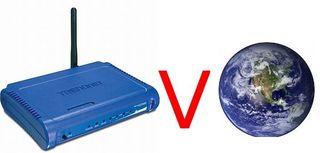Is your router killing the planet?

The European Commission is meeting with industry groups tomorrow to try and agree new regulations for power use in network adaptors. On the table are amendments to the European Ecodesign Directive which covers energy use for white goods around the home.
The changes being discussed involve the introduction of a compulsory standby mode for network adaptors, with maximum power consumption phased in over several years. Adaptors that need to wake within under one second will be allowed draw slightly more power in standby than those which are less essential. The actual limits are what will be on the table tomorrow.
The maximum limits being suggested are 4W for kit that doesn't need to turn on instantly and 12W for kit that does. The plan is to introduce those limits in 2014, and reduce them to 2W and 8W respectively by 2016. According to the European Commission, 40TWh per year - the equivalent of the residential electricity consumption of Sweden - can be saved across all of Europe plans are adopted.
Lobby group ECOS, the European Environmental Citizens Organisation for Standardisation, which represents environmental NGOs in Europe, reckon that an extra 8TWh per year of energy could be saved by giving consumers more ways to turn off their kit that don't involve reaching behind the sofa to pull out a plug. It recommends management software that let's you program shutdown times when you know you won't be using it. Like the early hours of the morning, for example.
Fortunately, this is an area which it shouldn't be too hard for manufacturers to agree to targets. Electricity is the single most important cost in datacentre design, and enormous amounts of R&D dollars have been spent making computing kit more efficient in exactly this area over the last few years.
The technology is already in use too: a quick test of equipment around my flat shows that Sitecom's enormously powerful Gaming Router II, with its dual band antennas and packet prioritisation engine, already draws just 4W when simply surfing the web use. The bigger culprit is the cable modem it's attached to, which is eating 6W consistently. That means together they meet the first phase requirements for a single device. While on the whole, the initiative is to be applauded, it might be that the energy savings hoped for are ambitious.
PC Gamer Newsletter
Sign up to get the best content of the week, and great gaming deals, as picked by the editors.
Most Popular





